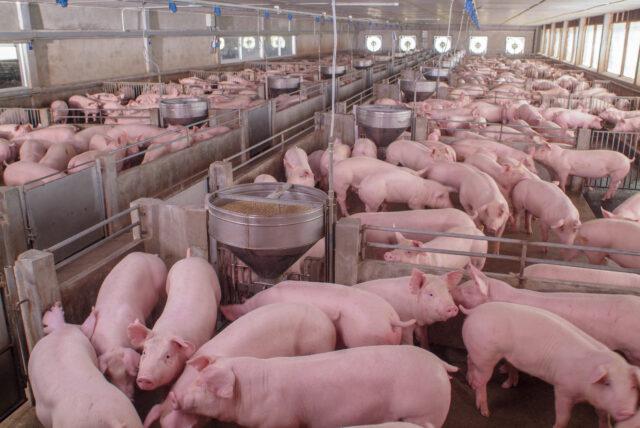Porto Alegre, September 8, 2023 – Recently, the attaché of the United States Department of Agriculture (USDA) in Beijing released the first projections for Chinese pig farming in 2024. It is worth noting that the attaché’s data are not yet official and may be changed in October by USDA, when the global meat sector report will be released. However, the data from the attaché already show some important perspectives for the world’s largest producer, consumer and importer of pork. As China is the main destination for Brazilian pork, in terms of exports, it deserves attention.
The first point to be made is that the attaché brought minor changes to the production and consumption estimates for 2023. The attaché estimates this year’s Chinese production at 56.5 mln tons, with an increase of 500 thousand tons compared to the last report. The 2023 production is the highest since 2014 if it is confirmed. For 2024, the attaché estimates 55.95 mln tons, down 0.97%.
The decline in production next year is natural, considering that the Chinese pig herd will decline, as a result of the strong pace of slaughter registered this year. Slaughter in China was projected by the attaché at 713.61 mln head in 2023, an increase of 1.95% compared to 699.95 mln head in 2022. For 2024, the slaughter was projected at 705 mln head. The final pig herd in China should close 2023 with 435 mln head, a decline of 3.88% compared to the 452.56 mln head registered in 2022. And for the end of 2024, the attaché estimates a further reduction, to 416.81 mln head.
China’s slaughter has been strong due to the losses registered by pig farmers over the year. The Chinese pork chain is faced with some negative factors, such as: the high supply of meat, less than ideal consumption, and high production cost. Faced with losses, producers with less efficiency end up withdrawing from the market and, at first, put larger volumes of animals for slaughter, resulting in a greater volume of meat in the local market. The Chinese government has been encouraging the disposal of less efficient matrices that do not compromise the investments made in the sector since 2018, when cases of African swine fever (ASF) broke out in the country. Food safety is a factor taken very seriously in China, so much so that the government adopts measures that aim to bring some sustainability to the sector, such as the purchase of frozen meat for state reserves and the availability of affordable credit.
For the January 1st, 2024 position, the herd of matrices in China was projected at 42 mln head, down 2.33% from the 43 mln head pointed at the beginning of 2023. It is
worth noting that last week the Chinese government pointed out that the herd of matrices was at 42.7 mln head at the end of July 2023.
As for the growth of slaughter and production and the decline in the herd in China, the numbers perfectly reflect the dynamics and cycle of the local market. What draws attention in the Chinese supply and demand picture of the attaché is the view around consumption, considering that for 2023 there is an optimistic outlook but for 2024 a more pessimistic idea. According to SAFRAS, the dynamics are the opposite, that is, consumption has slowed down at this moment, with acceleration expected from mid-2024. Chinese consumption in 2023 was estimated at 58.70 mln tons, up 2.2% from 55.43 mln tons indicated last year. For 2024, the attaché points to the consumption of 58.15 mln tons, down 0.93%.
The issue is that, despite the weak prices of pork this year in China, consumption should not close 2023 in a satisfactory way, considering that the Chinese economy is sharply slowing down, with a high degree of bankruptcy and with key sectors, such as real estate, giving signs of severe crisis, with large developers needing to be rescued. Consumer confidence in China is declining, and, given future uncertainties, consumption tightening is a consequence. Faced with the economic slowdown, the country is cutting interest rates and preparing stimulus packages, such as injecting liquidity into the system, going against the grain of developed countries around the world. The aim is to promote cheaper credit and domestic consumption, however, a more concrete effect of the measures on the real economy tends to happen in the medium term. Thus, the advance of investments and consumption should be seen in 2024.
The side effect of the decline in interest rates in the country is the flight of capital to more mature economies that have more attractive rates, such as the US, so much so that the yuan (Chinese currency) is losing strength, hovering around 7.30 for 1 dollar at the end of August. The devaluation of the yuan favors the country’s trade balance, since its products become more competitive in the international market, but its imports become more expensive. This is a factor that has led China to drop the dollar prices of animal proteins on the international market in the second half of the year (chicken, pork, and beef).
With the production and consumption data, the attaché shows that China should not increase pork imports next year. For 2024, Chinese imports were projected at 2.32 mln tons, against the 2.30 mln indicated for this year. USDA may revise the 2024 figure upward in October, considering that the local supply will be leaner and with a more favorable scenario for consumption.
Follow the Safras Agency on our website. Also follow us on our Instagram and Twitter and stay on top of the main agribusiness news!
Copyright 2023 – Grupo CMA

